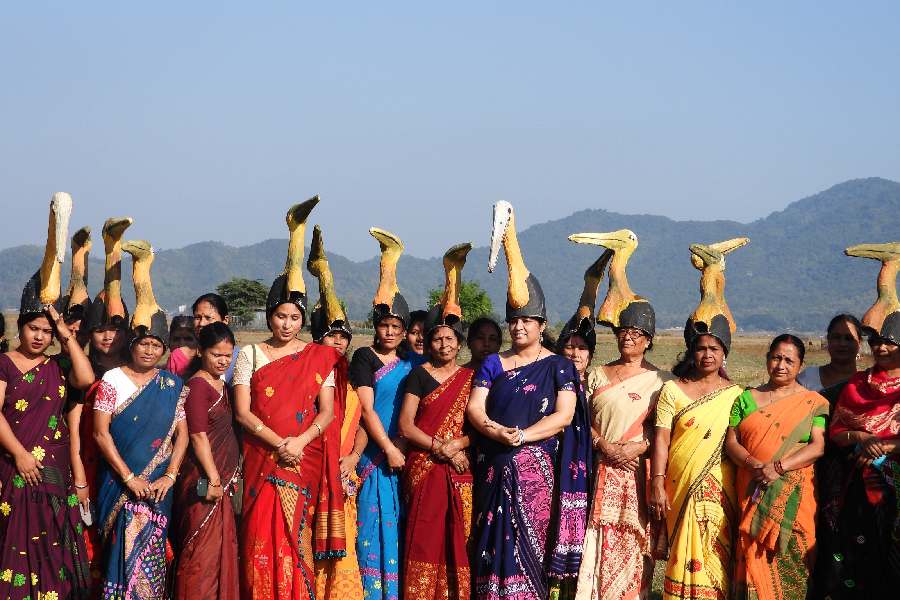March heralded World Wildlife Day, ushering in glad tidings from a woman conservationist in Assam. Meet the band of 20,000 women with whom Purnima Devi Barman leads the ‘Hargila army’ in Assam.
Hargila, literally meaning ‘bone swallower’, is the local name for the endangered greater adjutant stork. Capping an unrelenting campaign since 2007, Barman today runs the India chapter of Women in Nature Network, besides being associated with the Rewilding Academy and Aaranyak as a biologist. These years of efforts recently catapulted her to Time’s Women of the Year 2025 list, the only Indian to have made the cut.
The story of this bird and its conservation has now moved beyond the northeastern states to Bihar, Cambodia and even France. Barman, who happily recounts the genesis of her journey, says she was a PhD scholar and a young mother when she reacted to a tree being axed to kill the fledgling Hargila that had hatched on the branches. She rushed to save the nestlings that were falling off the tree and thus began a crusade of nearly two decades.

Capping an unrelenting campaign since 2007, Barman today runs the India chapter of Women in Nature Network, besides being associated with the Rewilding Academy and Aaranyak as a biologist
“It is not easy being a woman conservationist. There was a lot of opposition at the village level, because the greater adjutant stork is unpopular. It is a scavenger, not pleasing to the eye and has foul-smelling nests. In Assam, it was considered a bad omen,” explains Barman. Today, her ‘Hargila army’ has effectively used the bird as a motif on fabrics that are hand-woven by the women and sold to fund the programme. “My team was created by organising cooking competitions and through awareness campaigns,” she adds.
Initiating the campaign from the villages of Dadara, Pacharia and Singimari in Kamrup, Barman says that rehabilitating these birds “became my mission.” She shelved her doctoral thesis for a decade to focus on saving the storks and is happy that the Kulhati and the Morigaon wetlands now have a large nesting colony. By 2030, she envisions the population reaching 5,000 birds.
In 2017, when she was conferred the Whitley Award, also known as the Green Oscar, by Princess Anne of Britain, the statement read: “Purnima, 37, will scale up this work, encouraging householders to take pride in the species and protect the birds and their nesting trees.”
In these eight years, the effort to empower local communities has borne fruit. “We started going to prayer halls and temples, offering prasad for the Hargila. We went from school to school, raising awareness. I am seeking to engage youth leaders to take the conservation movement forward,” Barman stresses.

Although Barman has earned the support of the forest department, others of her mettle have had to withdraw after being intimidated by land sharks invariably opposed to preservation of natural resources and maintenance of ecological balance.
Interestingly, the first emblem of the Calcutta Municipal Corporation, a coat of arms created in 1896, sported two adjutant storks, each holding a serpent in its beak. It makes one wonder whether the peripheral East Kolkata Wetlands, a Ramsar site, has been able to contain the rapid decline in flora and fauna following unchecked urbanisation, encroachment and burgeoning real estate sector.
Crusaders like Barman have shown how sincere conservation efforts can catalyse a trickle-down effect and involve the very community that initially opposes such campaigns. While there are endangered species awaiting succour in the hills and plains, several campaigns are stymied by red tape and government apathy. Although Barman has earned the support of the forest department, others of her mettle have had to withdraw after being intimidated by land sharks invariably opposed to preservation of natural resources and maintenance of ecological balance. After all, can blatant land grab, extortions and so-called ‘development’ coexist with conservation? Time, surely, to replicate Assam’s ‘Hargila army’ wherever endangered species and habitats are at the mercy of spineless Homo sapiens.











